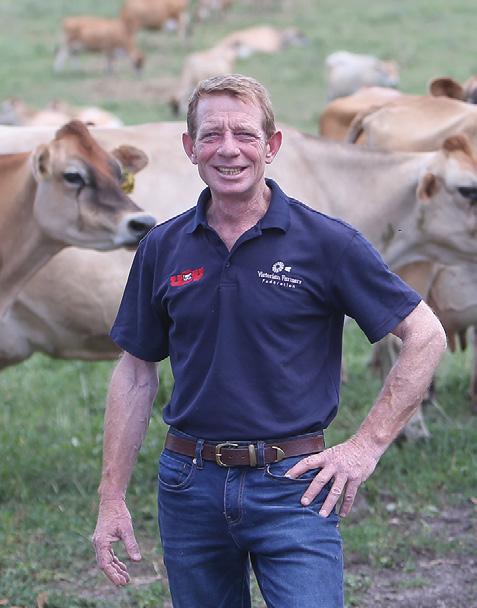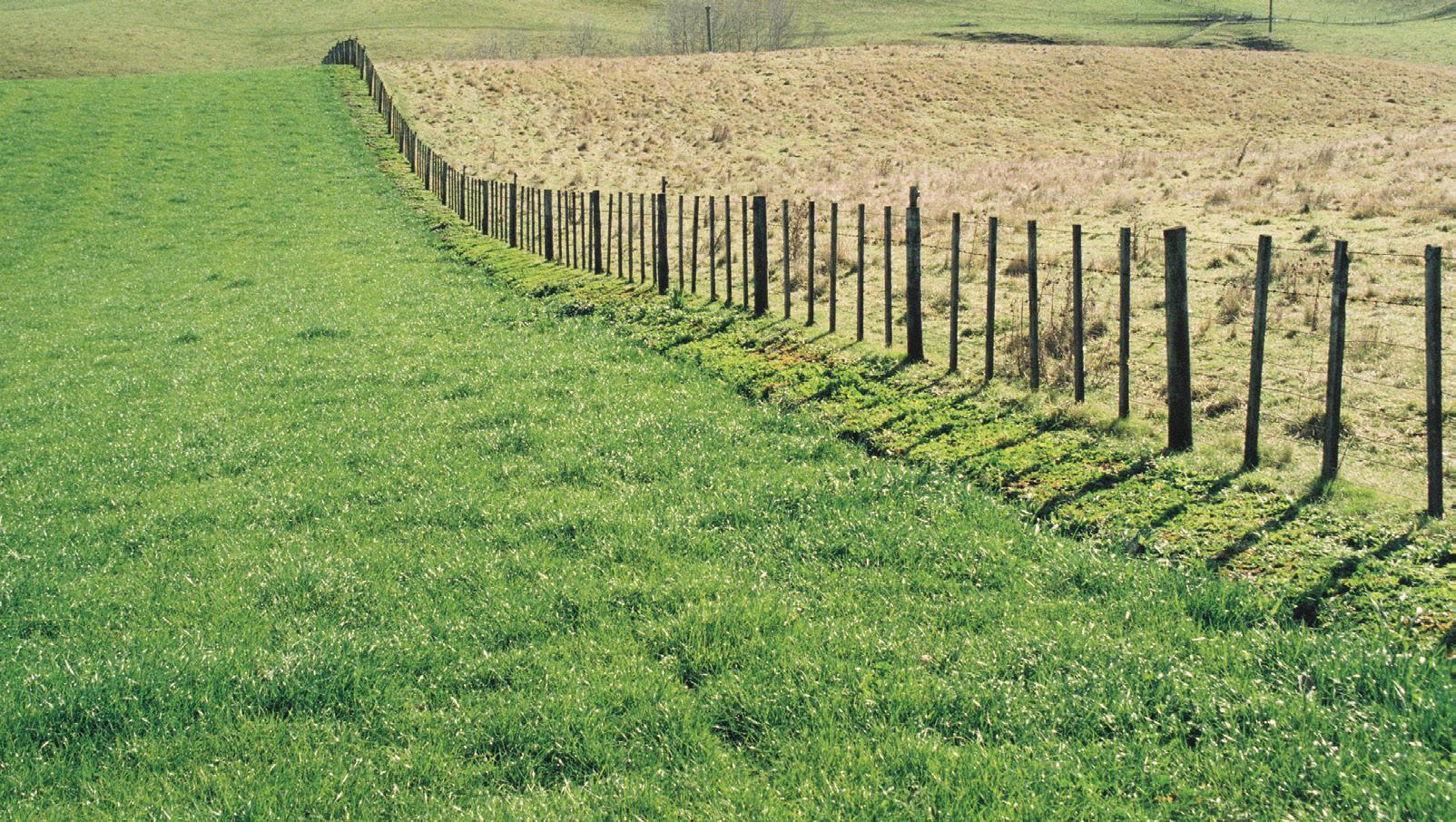
6 minute read
Dairy farms in Victoria are getting sold to beef producers
UPFRONT GLOBAL DAIRY - AUSTRALIA
SOLD -gone to beef
Milking an exit
Words by: Simone Smith
Favourable seasonal conditions, strong demand for milk and profitability at the farmgate.
It’s a good time to be a dairy farmer in southern Australia.
To anyone outside of the Australian dairy industry, this sounds like the perfect recipe for growth.
But the reality is a vastly different story.
“We’ve just experienced the best years ever to dairy farm and we are seeing a depletion,” United Dairyfarmers’ of Victoria president Paul Mumford said. “There’s obviously a reason.”
Milk production for the month of February was down 0.1% in Victoria – Australia’s largest milk production state, according to Dairy Australia. Year-to-date total Australian milk production was up 0.9%.
For the head of Victoria’s dairy lobby, the state’s static industry comes after years of challenges including milk price volatility, input price hikes, drought and floods.
But in the past year, Covid-19 has inflamed issues around the industry’s workforce, it’s “sleeping devil”, according to Paul.
“(The pandemic) has forced the labour onto the owners of the business and bought another added level of stress,” he said. “Coupled with that are the continued stress of production costs, weather, electricity or whatever other issues are bubbling away. This has allowed farmers to exit the industry. We are seeing a lot of farms sell out of dairy because the opportunity is positive to transition into beef.”
Beef farmers purchasing dairy operations has been a growing trend in the South Gippsland property market, in south east Victoria, according to SEJ Livestock and Real Estate licensed estate agent Irene Walker. The past four dairy farms she sold were purchased by beef producers.
Some rare smaller dairy farms, those which adjoin an existing dairy or larger operations have remained in the industry. But for the most part – those who milk cows have been priced out of the property market.
“Established beef families from the northeast of the state have been lured by the security of rainfall in this region,” Irene said. “They have more capacity (to purchase) - they have old money, family money and haven’t got debt. Plus, we are now dealing with Melbourne buyers who have taken their money out of commercial real estate and shares and are seeking more security by putting it into land.”
This shift in the market dynamic has been brewing for the past 10 years, according to Irene, “cemented” by recordbreaking beef prices in the past year.
Prices have reflected the uptick in demand. Irene said dairyland selling to beef has fetched $9500-$14,500 an acre, up from $6500-$8000/acre five years ago.
Yanakie dairy farmer Paul Hannigan will milk 340 cows this year – 50 less than last year – despite buying more land. He’s lost access to leased land and despite the new property, his total farming area has shrunk, and he’s had to destock. He viewed land as a secure investment but wondered what a declining industry would mean for those who continue to milk cows.
“For us, I’d like to think what we have now (property) is worth more than what we paid for it, I know it is and a fair bit more,” he said.
“I can’t see how returns will be any less with a shrinking milk pool, but at some stage it could tip the other way and we could start importing more and the export market won’t be there.”
Chris Nixon milks 500 cows and runs 2000 beef breeders in the bushfire ravaged region of far eastern Victoria.
For the first time in his farming career, his beef operation has been more profitable than the dairy for the past 18 months. While he won’t be selling his milkers, he understands why farmers are choosing beef over dairy.
“There are big issues overhanging our dairy industry and it hasn’t given farmers the confidence to go forward,” he said. “The reason the industry hasn’t gone forward like it should have has been because of tough seasonal conditions, a reduction in water, probably higher than average labour costs and the overhang of the supermarket duopoly on price. That’s why it’s hard to see clear air on a forward sustainable price.”

Paul Mumford: United Dairyfarmers’ of Victoria president Paul Mumford said the Covid-19 pandemic has exposed a workforce issue within the state’s dairy industry. SOURCE: UDV LEFT: Dairy farms in South Gippsland have been snapped-up by beef producers or Melbourne buyers.
Pasture & Forage News
May 2021

If your farm is to go forward - pastures may need culling
A critical part of herd improvement comes at the end of every season, when the cows you’ve identified as performing well below the others, are removed from the herd to make way for new blood.
Pastures are no different – they need culling too, if your farm is to go forward. Some will have been very productive over the past 12 months; others will have let you down. It’s time to sort the good from the bad, and make a plan to turn poor performers into stars. Pasture growth varies hugely from paddock to paddock across every farm. On flat land, a 100% difference in DM yield between best and worst paddocks is typical. This figure is much higher on hilly farms. If your poor paddocks are growing 6t DM/ha less than your best, which is common, they’re giving you 300kg MS/ha less (based on 75% utilisation and 15kg DM/kg MS conversion). One way to find out how much individual paddocks grow is to review your grazing records. Good paddocks might be grazed 12-13 times a year, poor paddocks 6-7 times a year. A single grazing might be 1 to 1.5 t DM/ha of pasture, so you can add up how much each has grown. For more detail on recording grazing days, visit www.barenbrug. co.nz. Some recording software (e.g. Pasture Coach, Agrinet or Minda Land and Feed) does this automatically if you’ve collected weekly pasture cover data. An example of this analysis for the Lincoln University Dairy Farm (LUDF) is below. For each soil type, the difference in t DM/ha of pasture eaten between the best and worst paddock shows just how much production the farm has missed out on. The next step is to look at what to do with these under-performing paddocks. Should you soil test? Apply extra fertiliser or herbicide? Oversow clover? Improve drainage? Put them into spring crop? There are several options to consider, with the aim of getting your farm’s pasture performance to the highest level possible. We can help – hop on our website and book a free pasture health check with your local Barenbrug agronomist.
Play it safe with crop transition
If anything is going to go wrong with your transition this year, it will most likely happen in the first week of changing animals from one diet to another.
That is the time when most animal health issues – and sometimes deaths – occur, so you take care preparing for this. Allow enough time for animals adapt to a different feed source. The rumen is a complex fermentation system, full of billions of microbes, and they do not like sudden changes. You can transition onto brassicas in a shorter time than fodder beet, but in both cases, a gradual introduction of the new feed is all-important to prevent problems like scouring, acidosis and nitrate poisoning. Putting hungry animals onto any crop is a recipe for disaster – they will eat too much, too fast, so always make sure they have something in their bellies first, whether it’s hay, silage or straw. Watch them carefully – things can go wrong very quickly, and some animals just don’t do well on crop, meaning they will need to be removed and put back onto pasture. Visit our website to find detailed transition advice.











